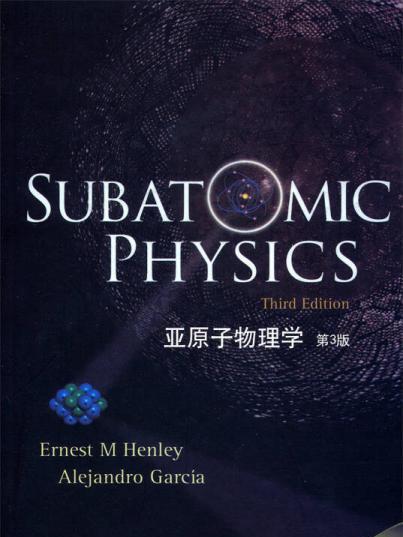內容簡介
SubatomicPhysics,thephysicsofnucleiandparticles,hasbeenoneofthefrontiersofsciencesinceitsbirthin1896.FromthestudyoftheradiationsemittedbyradioactivenucleitothescatteringexperimentsthatpointtothepresenceofsubLuutsinnucleons,fromthediscoveryofthehadrorucinteractionstothereal-izationthatthephotonpossesseshadronic(strong)attributes,andthatweakandelectromagneticforcesmaybeintimatelyrelated,subatomicphysicshasenrichedsciencewithnewconceptsanddeeperinsightsintothelawsofnature.
SubatomicPhysicsdoesnotstandisolated;itbearsonmanyaspectsoflife.Ideasandfactsemergingfromstudiesofthesubatomicworldchangeourpictureofthemacrocosmos.Conceptsdiscoveredinsubatomicphysicsareneededtounder-standthecreationandabundanceoftheelements,andtheenergyproductioninthesunandthestars,Nuclearpowermayprovidemostofthefutureenergysources.Nuclearbombsaffectnationalandinternationaldecisions.Pionbeamshavebe-comeatooltotreatcancer.TracerandMossbauertechniquesgiveinformationaboutstructureandreactionsinsolidstatephysics,chemistry,biology,metallurgy,andgeology.
目錄
Dedication
Acknowledgments
PrefacetotheFirstEdition
PrefacetotheThirdEdition
GeneralBibliography
1BackgroundandLanguage
1.1OrdersofMagnitude
1.2Units
1.3SpecialRelativity,FeynmanDiagrams
1.4References
ⅠTools
2Accelerators
2.1WhyAccelerators?
2.2CrossSectionsandLuminosity
2.3ElectrostaticGenerators(VandeGraaff)
2.4LinearAccelerators(Linacs)
2.5BeamOptics
2.6Synchrotrons
2.7LaboratoryandCenter-of-MomentumFrames
2.8CollidingBeams
2.9SuperconductingLinacs
2.10BeamStorageandCooling
2.11References
3PassageofRadiationThroughMatter
3.1Concepts
3.2HeavyChargedParticles
3.3Photons
3.4Electrons
3.5NuclearInteractions
3.6References
4Detectors
4.1ScintillationCounters
4.2StatisticalAspects
4.3SemiconductorDetectors
4.4BubbleChambers
4.5SparkChambers
4.6WireChambers
4.7DriftChambers
4.8TimeProjectionChambers
4.9CerenkovCounters
4.10Calorimeters
4.11CounterElectronics
4.12Electronics:Logic
4.13References
ⅡParticlesandNuclei
5TheSubatomicZoo
5.1MassandSpin.FermionsandBosons
5.2ElectricChargeandMagneticDipoleMoment
5.3MassMeasurements
5.4AFirstGlanceattheSubatomicZoo
5.5GaugeBosons
5.6Leptons
5.7Decays
5.8Mesons
5.9BaryonGroundStates
5.10ParticlesandAntiparticles
5.11Quarks,Gluons,andIntermediateBosons
5.12ExcitedStatesandResonances
5.13ExcitedStatesofBaryons
5.14References
6StructureofSubatomicParticles
6.1TheApproach:ElasticScattering
6.2RutherfordandMottScattering
6.3FormFactors
6.4TheChargeDistributionofSphericalNuclei
6.5LeptonsArePointParticles
6.6NucleonElasticFormFactors
6.7TheChargeRadiiofthePionandKaon
6.8InelasticElectronandMuonScattering
6.9DeepInelasticElectronScattering
6.10Quark-PartonModelforDeepInelasticScattering
6.11MoreDetailsonScatteringandStructure
6.12References
ⅢSymmetriesandConservationLaws
7AdditiveConservationLaws
7.1ConservedQuantitiesandSymmetries
7.2TheElectricCharge
7.3TheBaryonNumber
7.4LeptonandLeptonFlavorNumber
7.5StrangenessFlavor
7.6AdditiveQuantumNumbersofQuarks
7.7References
8AngularMomentumandIsospin
8.1InvarianceUnderSpatialRotation
8.2SymmetryBreakingbyaMagneticField
8.3ChargeIndependenceofHadronicForces
8.4TheNucleonIsospin
8.5IsospinInvariance
8.6IsospinofParticles
8.7IsospininNuclei
8.8References
9P,C,CP,andT
9.1TheParityOperation
9.2TheIntrinsicParitiesofSubatomicParticles
9.3ConservationandBreakdownofParity
9.4ChargeConjugation
9.5TimeReversal
9.6TheTwo-StateProblem
9.7TheNeutralKaons
9.8TheFallofCPInvariance
9.9References
ⅣInteractions
10TheElectromagneticInteraction
10.1TheGoldenRule
10.2PhaseSpace
10.3TheClassicalElectromagneticInteraction
10.4PhotonEmission
10.5MultipoleRadiation
10.6ElectromagneticScatteringofLeptons
10.7VectorMesonsasMediatorsofthePhoton-HadronInteraction
10.8CollidingBeams
10.9Electron-PositronCollisionsandQuarks
10.10ThePhoton-HadronInteraction:RealandSpacelikePhotons
10.11MagneticMonopoles
10.12References
11TheWeakInteraction
11.1TheContinuousBetaSpectrum
11.2BetaDecayLifetimes
11.3TheCurrent-CurrentInteractionoftheStandardModel
11.4AVarietyofWeakProcesses
11.5TheMuonDecay
11.6TheWeakCurrentofLeptons
11.7ChiralityversusHelicity
11.8TheWeakCouplingConstantGF
11.9WeakDecaysofQuarksandtheCKMMatrix
11.10WeakCurrentsinNuclearPhysics
11.11InverseBetaDecay:ReinesandCowan'sDetectionofNeutrinos
11.12MassiveNeutrinos
11.13MajoranaversusDiracNeutrinos
11.14TheWeakCurrentofHadronsatHighEnergies
11.15References
12IntroductiontoGaugeTheories
12.1Introduction
12.2PotentialsinQuantumMechanics-TheAharonov-BohmEffect
12.3GaugeInvarianceforNon-AbelianFields
12.4TheHiggsMechanism;SpontaneousSymmetryBreaking
12.5GeneralReferences
13TheElectroweakTheoryoftheStandardModel
13.1Introduction
13.2TheGaugeBosonsandWeakIsospin
13.3TheElectroweakInteraction
13.4TestsoftheStandardModel
13.5References
14StrongInteractions
14.1RangeandStrengthoftheLow-EnergyStrongInteractions
14.2ThePion-NucleonInteraction-Survey
14.3TheFormofthePion-NucleonInteraction
14.4TheYukawaTheoryofNuclearForces
14.5Low-EnergyNucleon-NucleonForce
14.6MesonTheoryoftheNucleon-NucleonForce
14.7StrongProcessesatHighEnergies
14.8TheStandardModel,QuantumChromodynamics
14.9QCDatLowEnergies
14.10GrandUnifiedTheories,Supersymmetry,StringTheories
14.11References
ⅤModels
15QuarkModelsofMesonsandBaryons
15.1Introduction
15.2QuarksasBuildingBlocksofHadrons
15.3HuntingtheQuark
15.4MesonsasBoundQuarkStates
15.5BaryonsasBoundQuarkStates
15.6TheHadronMasses
15.7QCDandQuarkModelsoftheHadrons
15.8HeavyMesons:Charmonium,Upsilon
15.9OutlookandProblems
15.10References
16LiquidDropModel,FermiGasModel,HeavyIons
16.1TheLiquidDropModel
16.2TheFermiGasModel
16.3HeavyIonReactions
16.4RelativisticHeavyIonCollisions
16.5References
17TheShellModel
17.1TheMagicNumbers
17.2TheClosedShells
17.3TheSpin-OrbitInteraction
17.4TheSingle-ParticleShellModel
17.5GeneralizationoftheSingle-ParticleModel
17.6IsobaricAnalogResonances
17.7NucleiFarFromtheValleyofStability
17.8References
18CollectiveModel
18.1NuclearDeformations
18.2RotationalSpectraofSpinlessNuclei
18.3RotationalFamilies
18.4One-ParticleMotioninDeformedNuclei(NilssonModel)
18.5VibrationalStatesinSphericalNuclei
18.6TheInteractingBosonModel
18.7HighlyExcitedStates;GiantResonances
18.8NuclearModels-ConcludingRemarks
18.9References
19NuclearandParticleAstrophysics
19.1TheBeginningoftheUniverse
19.2PrimordialNucleosynthesis
19.3StellarEnergyandNucleosynthesis
19.4StellarCollapseandNeutronStars
19.5CosmicRays
19.6NeutrinoAstronomyandCosmology
19.7LeptogenesisasBasisforBaryonExcess
19.8References
Index

